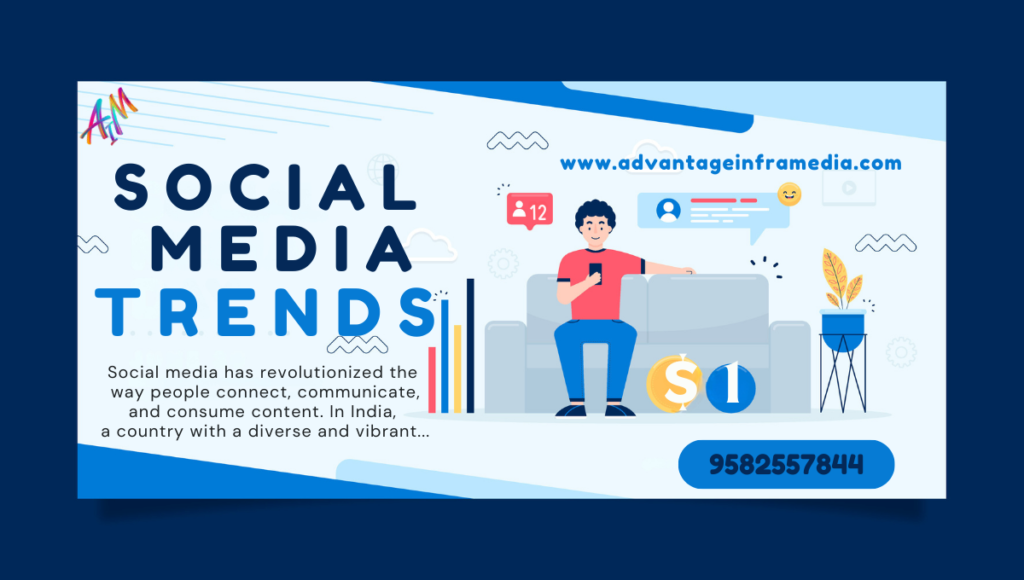Introduction
Social media has revolutionized the way people connect, communicate, and consume content. In India, a country with a diverse and vibrant digital landscape, social media platforms have become an integral part of daily life. As of 2024, several trends are shaping the social media ecosystem in India. This blog explores these trends, providing insights into how they influence users, brands, and the broader society.
The Rise of Social Media in India
India’s social media journey has been extraordinary. With over 650 million internet users and an expanding base of digital consumers, the country has seen rapid growth in social media adoption. From the early days of Orkut and Facebook to the contemporary dominance of Instagram, WhatsApp, and YouTube, the landscape has evolved significantly.
The Dominance of Short-form Video Content
The TikTok Effect and Its Aftermath
The ban on TikTok in 2020 led to a surge in indigenous short-form video apps like Josh, Moj, and MX TakaTak. In 2024, short-form video content continues to dominate, with platforms like Instagram Reels, YouTube Shorts, and newer entrants vying for users’ attention.
Key Players: Instagram Reels, YouTube Shorts, and Local Alternatives
Instagram Reels and YouTube Shorts have become the go-to platforms for short-form content creators. Meanwhile, local platforms like Moj and Josh are also thriving, catering to regional audiences and niche communities.
The Influence of Creator Economy
The creator economy in India is booming, with influencers and content creators monetizing their content through brand partnerships, advertisements, and direct fan support via platforms like Patreon and Buy Me a Coffee.
The Surge in Regional Language Content
The Importance of Vernacular Languages
With over 22 officially recognized languages, India’s social media landscape is increasingly embracing regional language content. Platforms and brands are leveraging this trend to reach a broader audience base.
Localizing Content for Diverse Audiences
Content localization goes beyond mere translation. It involves adapting cultural nuances and context to resonate with regional audiences. This strategy has proven effective for platforms and brands aiming to engage more deeply with users across different states.
Regional Influencers and Their Growing Impact
Regional influencers, or micro-influencers, are gaining prominence. They have a strong connection with their audience, often more than national or global influencers, due to shared cultural and linguistic ties.
The Evolution of E-commerce on Social Media
Social Commerce on the Rise
The fusion of e-commerce and social media, known as social commerce, is gaining momentum in India. Platforms like Instagram and WhatsApp are integrating shopping features, allowing users to browse and purchase products without leaving the app.
Livestream Shopping: The New Shopping Experience
Livestream shopping, popularized by platforms like Taobao in China, is emerging in India. Influencers and brands host live sessions where they showcase products, interact with viewers, and offer exclusive deals.
The Role of AI and AR in Enhancing Shopping Experiences
Artificial Intelligence (AI) and Augmented Reality (AR) are transforming the shopping experience on social media. AI-driven recommendations and AR-based try-ons provide personalized and immersive shopping experiences.
The Influence of Gen Z and Millennials
Understanding the Digital Natives
Gen Z and Millennials are the primary drivers of social media trends. Their preferences and behaviors are shaping how platforms evolve and how content is created and consumed.
The Shift Towards Authenticity and Relatability
These younger audiences crave authentic and relatable content. They favor platforms and creators that showcase genuine experiences and avoid overly polished or commercialized content.
The Rise of Meme Culture and Digital Communities
Memes have become a universal language for Gen Z and Millennials. Meme culture and digital communities centered around shared interests are thriving, often dictating what goes viral.
The Growing Popularity of Ephemeral Content
Stories and Status Updates
Ephemeral content, which disappears after a set period, is highly popular. Instagram Stories, WhatsApp Status, and Snapchat Stories are key examples, offering users a way to share moments without the permanence of regular posts.
The Appeal of Fleeting Moments
This type of content appeals due to its temporary nature, encouraging spontaneous and candid sharing. It also fosters a sense of urgency and exclusivity among viewers.
Strategic Use by Brands and Influencers
Brands and influencers leverage ephemeral content for time-sensitive promotions, behind-the-scenes glimpses, and interactive engagement, such as polls and Q&A sessions.
The Role of Social Media in Politics and Social Movements
The Digital Battleground for Political Campaigns
Social media has become a critical platform for political campaigns. Politicians and parties use it to reach voters, shape public opinion, and mobilize supporters.
Amplifying Voices and Social Causes
Social media platforms are powerful tools for amplifying voices and driving social change. Movements like #MeToo and #BlackLivesMatter have found significant traction in India, sparking nationwide conversations and actions.
The Challenges of Misinformation and Digital Etiquette
The proliferation of misinformation and the need for digital etiquette are ongoing challenges. Platforms are increasingly under scrutiny to implement measures to combat fake news and ensure respectful discourse.
The Integration of Augmented Reality (AR) and Virtual Reality (VR)
Enhancing User Engagement with AR Filters and VR Experiences
AR and VR technologies are enhancing user engagement on social media. AR filters, popular on Instagram and Snapchat, allow users to create immersive and interactive content. VR is being explored for more immersive social experiences.
The Future of Social Media with the Metaverse
The concept of the metaverse, a collective virtual shared space, is gaining traction. Social media giants like Facebook (now Meta) are investing heavily in creating interconnected virtual worlds where users can socialize, work, and play.
Opportunities and Challenges for Brands
For brands, AR and VR offer new ways to engage with audiences. However, the adoption of these technologies also comes with challenges, such as the need for significant investment and addressing user privacy concerns.
The Impact of Privacy Concerns and Regulatory Changes
Growing Awareness and Demand for Privacy
Users are becoming more aware of their digital footprints and demanding greater privacy and data security. This trend is influencing how platforms handle user data and implement privacy features.
Navigating the Regulatory Landscape
Regulatory changes, such as the IT Rules 2021, impact how social media platforms operate in India. Platforms must navigate these regulations while balancing user engagement and compliance.
The Role of Decentralized Platforms and Data Ownership
Decentralized social media platforms, built on blockchain technology, are emerging as alternatives that offer users more control over their data and content.
The Expanding Role of Influencers and Brand Collaborations
The Evolution of Influencer Marketing
Influencer marketing continues to evolve, with influencers becoming essential partners for brands. Collaborations range from product endorsements to co-creating content that aligns with the influencer’s style and audience.
Micro-Influencers: The Power of Niche Audiences
Micro-influencers, with their smaller but highly engaged audiences, are increasingly valuable. They offer authentic connections and often have greater influence within specific niches.
Influencer-Led Brands and Entrepreneurship
Many influencers are leveraging their online presence to launch their own brands and entrepreneurial ventures, creating new revenue streams and expanding their influence beyond social media.
The Integration of AI and Machine Learning in Content Creation
AI-Driven Content Generation and Personalization
AI and machine learning are transforming content creation and personalization. Algorithms analyze user preferences to recommend tailored content, enhancing user engagement and satisfaction.
The Rise of Virtual Influencers
Virtual influencers, computer-generated characters with realistic personalities and appearances, are gaining popularity. They offer brands a new way to engage with audiences and explore creative marketing strategies.
Ethical Considerations and Future Prospects
The use of AI in content creation raises ethical considerations, such as transparency and the potential for deepfakes. As these technologies advance, platforms and creators must navigate these challenges responsibly.
Conclusion
As India’s social media landscape continues to evolve, staying abreast of these trends is crucial for users, brands, and policymakers. From the dominance of short-form videos to the rise of social commerce and the integration of AR/VR technologies, the trends of 2024 reflect a dynamic and rapidly changing digital ecosystem. By understanding and adapting to these trends, stakeholders can effectively navigate the future of social media in India.
References
- Internet and Mobile Association of India (IAMAI) reports on digital usage.
- Analysis from industry experts and market research firms.
- Case studies and examples from leading social media platforms and brands.
Detailed Blog
Social Media Trends in India in 2024
Social media has become an integral part of the daily lives of millions of Indians. As of 2024, the landscape is marked by significant changes driven by technological advancements, evolving user preferences, and the dynamic interplay of cultural and economic factors. This blog delves into the top social media trends in India for 2024, providing a comprehensive view of how these trends are shaping the digital ecosystem.
The Rise of Social Media in India
The growth of social media in India has been nothing short of phenomenal. With the country boasting over 650 million internet users, social media platforms have become central to how people communicate, entertain, and inform themselves. From the days when Orkut and Facebook were the primary channels for social interactions, the scene has dramatically transformed with the advent of new platforms and content forms.
The Dominance of Short-form Video Content
In the past few years, short-form video content has taken center stage. This trend, largely catalyzed by the popularity of TikTok before its ban in 2020, has led to the rise of numerous local and global platforms catering to the Indian audience.
The TikTok Effect and Its Aftermath: After TikTok’s exit, platforms like Instagram Reels and YouTube Shorts quickly filled the void, while local apps such as Moj and Josh gained significant traction. These platforms have become crucial for users looking to create and consume quick, engaging content.
Key Players: Instagram Reels and YouTube Shorts are now the dominant platforms for short-form videos. They offer creators a broad reach and various monetization options. Meanwhile, local alternatives like Moj and Josh continue to thrive, offering regional content and catering to specific linguistic and cultural niches.
The Influence of Creator Economy: The creator economy is flourishing in India. Influencers and content creators are increasingly monetizing their work through brand collaborations, ads, and fan-supported models. Platforms like Patreon and Buy Me a Coffee enable creators to receive direct support from their audiences, fostering a more sustainable and independent revenue model.
The Surge in Regional Language Content
India’s linguistic diversity is a significant factor in the social media landscape. With over 22 officially recognized languages and hundreds of dialects, there’s a growing emphasis on regional language content.
The Importance of Vernacular Languages: Social media platforms are increasingly supporting content in regional languages to cater to a broader audience. This trend is helping to democratize content creation and consumption, making social media more inclusive.
Localizing Content for Diverse Audiences: Effective localization goes beyond translation. It involves understanding cultural nuances and contextual relevance. Brands and content creators who adapt their content to regional preferences are seeing higher engagement rates.
Regional Influencers and Their Growing Impact: Regional influencers are becoming powerful voices on social media. Their ability to connect with local audiences in their native languages gives them a unique edge. These influencers often enjoy a more personal and trusted relationship with their followers, making them valuable for brands targeting specific regions.
The Evolution of E-commerce on Social Media
The integration of e-commerce with social media, known as social commerce, is transforming how Indians shop online. Social media platforms are becoming key drivers of online sales.
Social Commerce on the Rise: Instagram and WhatsApp are leading the way in integrating shopping features directly into their platforms. Users can browse catalogs, engage with brands, and make purchases without leaving the app, creating a seamless shopping experience.
Livestream Shopping: Inspired by the success of livestream shopping in China, this trend is gaining traction in India. Brands and influencers host live sessions where they showcase products, answer questions, and offer exclusive discounts, creating a dynamic and interactive shopping experience.
The Role of AI and AR in Enhancing Shopping Experiences: AI-driven personalization and AR-based try-ons are revolutionizing social commerce. These technologies help in offering tailored recommendations and immersive experiences, making online shopping more engaging and efficient.
The Influence of Gen Z and Millennials
Gen Z and Millennials are not just active social media users; they are trendsetters who shape the direction of social media.
Understanding the Digital Natives: These generations have grown up with digital technologies. Their expectations for instant access to information, entertainment, and communication are driving the evolution of social media platforms.
The Shift Towards Authenticity and Relatability: Young audiences value authenticity. They prefer content that is relatable and genuine, often favoring influencers and brands that show real, unpolished moments over highly curated posts.
The Rise of Meme Culture and Digital Communities: Memes have become a primary form of communication and entertainment for Gen Z and Millennials. Digital communities built around shared interests and humor are flourishing, influencing what becomes popular on social media.
The Growing Popularity of Ephemeral Content
Ephemeral content, which is available only for a short period, is highly popular among users who enjoy sharing fleeting moments.
Stories and Status Updates: Features like Instagram Stories, WhatsApp Status, and Snapchat Stories allow users to post content that disappears after 24 hours. This encourages more spontaneous and less curated sharing.
The Appeal of Fleeting Moments: The temporary nature of ephemeral content creates a sense of urgency and exclusivity. Users are more likely to engage with content when they know it won’t be available forever.
Strategic Use by Brands and Influencers: Brands and influencers use ephemeral content to create buzz around limited-time offers, provide behind-the-scenes glimpses, and engage audiences with interactive features like polls and Q&A sessions.
The Role of Social Media in Politics and Social Movements
Social media is a powerful tool in the political and social arenas, amplifying voices and driving change.
The Digital Battleground for Political Campaigns: Political parties and candidates leverage social media to reach and engage with voters, especially during election campaigns. Platforms like Facebook, Twitter, and Instagram are used to share campaign messages, mobilize supporters, and shape public opinion.
Amplifying Voices and Social Causes: Social media has been instrumental in amplifying voices and supporting social movements. Campaigns like #MeToo and #BlackLivesMatter have found resonance in India, prompting widespread discussion and action on critical issues.
The Challenges of Misinformation and Digital Etiquette: The spread of misinformation and the need for respectful discourse are ongoing challenges. Social media platforms are under pressure to implement measures to combat fake news and promote digital etiquette.
The Integration of Augmented Reality (AR) and Virtual Reality (VR)
AR and VR are becoming integral parts of the social media experience, offering new ways for users to interact and engage.
Enhancing User Engagement with AR Filters and VR Experiences: AR filters, popular on platforms like Instagram and Snapchat, allow users to create immersive and interactive content. VR is being explored for more immersive social experiences, where users can interact in virtual spaces.
The Future of Social Media with the Metaverse: The concept of the metaverse, a collective virtual shared space, is gaining traction. Companies like Meta (formerly Facebook) are investing heavily in creating interconnected virtual worlds where users can socialize, work, and play.
Opportunities and Challenges for Brands: AR and VR provide brands with innovative ways to engage customers. However, these technologies also pose challenges, such as the need for significant investment and addressing user privacy and security concerns.
The Impact of Privacy Concerns and Regulatory Changes
As users become more aware of their digital footprints, privacy and data security are becoming critical concerns.
Growing Awareness and Demand for Privacy: Users are increasingly concerned about how their data is used and protected. This trend is pushing social media platforms to enhance their privacy features and provide more transparency.
Navigating the Regulatory Landscape: Regulatory changes, such as India’s IT Rules 2021, impact how social media platforms operate. These rules require platforms to adhere to stricter guidelines on content moderation, data protection, and user rights.
The Role of Decentralized Platforms and Data Ownership: Decentralized social media platforms, which use blockchain technology to give users more control over their data, are emerging as alternatives. These platforms offer a new model for data ownership and content control.
The Expanding Role of Influencers and Brand Collaborations
Influencers continue to play a crucial role in shaping consumer behavior and driving brand engagement on social media.
The Evolution of Influencer Marketing: Influencer marketing is evolving with influencers becoming key partners for brands. Collaborations range from simple product endorsements to co-creating content that aligns with the influencer’s style and audience.
Micro-Influencers: The Power of Niche Audiences: Micro-influencers, who have smaller but highly engaged audiences, are increasingly valuable. They often have more authentic connections with their followers and can be more effective for brands targeting specific demographics or interests.
Influencer-Led Brands and Entrepreneurship: Many influencers are leveraging their online presence to launch their own brands or entrepreneurial ventures. This trend reflects the growing influence of social media personalities beyond their online platforms.
The Integration of AI and Machine Learning in Content Creation
AI and machine learning are transforming how content is created and personalized on social media.
AI-Driven Content Generation and Personalization: AI is increasingly used to generate and recommend content tailored to individual preferences. This enhances user engagement by delivering more relevant and interesting content.
The Rise of Virtual Influencers: Virtual influencers, created using AI, are gaining popularity. These computer-generated characters can engage with audiences and collaborate with brands in unique ways, offering new possibilities for digital marketing.
Ethical Considerations and Future Prospects: The use of AI in content creation raises ethical questions, such as the potential for deepfakes and the need for transparency. As these technologies advance, it will be important for platforms and creators to navigate these challenges responsibly.
Conclusion
India’s social media landscape in 2024 is dynamic and rapidly evolving. From the rise of short-form video content and regional language engagement to the integration of AR/VR and the growing importance of privacy, these trends are reshaping how users interact, how brands engage, and how platforms operate. By understanding these trends, stakeholders can effectively navigate and thrive in the future of social media in India.
References
- IAMAI Digital Reports: Comprehensive insights into India’s digital landscape.
- Industry Analyses and Market Research: Data and trends from leading research firms and experts.
- Platform Case Studies: Examples from major social media platforms and brands adapting to these trends.
This draft provides a thorough exploration of the social media trends in India for 2024. Adjustments can be made to focus more on specific areas or include additional insights based on further research and developments.





